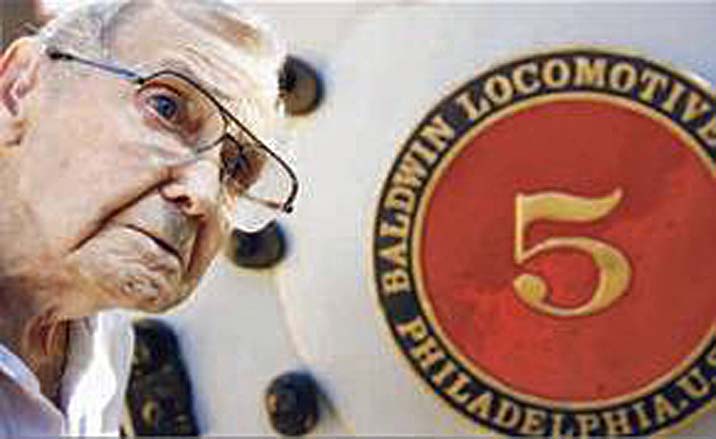John Taggart was the last engineer on the Manitou and Pikes Peak Cog Railway to regularly run steam locomotives - Date unknown Todd Spoth. 21 October 2007 Head Full of Steam The folks at the cog railway knew that if they were going to engineer the revival of the old No. 4, they'd better call John Taggart.
The No. 4 is the last viable steam locomotive on the Manitou and Pikes Peak Cog Railway.
But it's far from ready to pull cars up the tracks.
And the only person who really knows its secrets is Taggart, the 89-year-old retired engineer who worked on the railway for 48 years and is the last man alive who regularly drove the 110-year-old steamer.
That was back in the 1950s.
These days, no one at the cog really knows how to drive, let alone fix, an old steam engine.
And Taggart's memory is getting a little fuzzy.
Don't ask him about names and dates.
But his memory of working the train is still clear as a whistle.
"Running that old thing is something I'll never forget," he said.
So on a recent morning, the manager of the cog railway invited him to meet with a steam engine specialist the railway has hired to restore the old No. 4.
Marlin Uhrich, who has brought several old locomotives in the state back to life, crouched, peering into the iron innards of the engine.
He looked up as Taggart walked into the dark shed where No. 4 has sat for years under a coat of dust and cobwebs.
Here was something he'd rarely seen, a steam engineer standing next to his engine, not a hobby guy, but the real thing.
Uhrich walked over with a broad smile and shook Taggart's hand.
"Let's see if we can?t put our heads together and get this old girl percolating again," Uhrich said, taking out a notebook.
Cog owners hope the engine can occasionally pull special trains, though never all the way to the summit.
Repairs could cost $50,000, but manager Spencer Wren says it's worth it to restore a living part of the track's heritage. Family Ties The old No. 4 goes back a long way, but Taggart's railway connection goes back longer.
The No. 4 was built in 1896, when the railroad was only a few years old.
The only thing that goes back further is the Taggart family itself.
Three generations have worked on the railway since the first ties were laid.
His grandfather, John B. Taggart, who grew up in the region, was one of an army of workers who, for 18 cents an hour, chipped, shoveled, and blasted the grade to the summit of Pikes Peak from 1889 to 1890.
Six men died building the track.
Uncounted more gave up after a few days' work because swinging a pick in the icy, thin, air above tree line was so hard.
John B. Taggart stuck with it.
After the track was finished, he worked on the section crew that maintained the rails.
In 1895 he was living with his wife in a tiny stone maintenance hut at 12,500 feet on Pikes Peak when she gave birth to the only baby ever known to be born above tree line on the peak, Brough Taggart.
Brough worked the section crew like his father.
He eventually became the crew foreman, like his father.
And in 1935, he hired his own son, John, to join the crew.
"I grew up on the track, ever since I was a snot-nosed kid. It's always been railroads for me," the youngest Taggart said, remembering how he worked under his father for years.
He and his late wife never had children, so the Taggart cog dynasty ends with him.
In the 1930s, the family lived in a small cluster of houses at Minnehaha, a spot a few miles up the mountain.
John Taggart's mother cooked meals for the whole crew.
The young men who worked the track slept in a bunkhouse made from an old Colorado Springs streetcar.
Every day they caught the train up to the spot where they were working.
Every afternoon they would shoot back to "Minne" on homemade toboggans that fit on the rails.
"We got going pretty good," Taggart said, smiling as he remembered flying down the tracks.
"You could make it from Minne to town in just a few minutes. But then one of the bosses," Mr. Tutt if Taggart remembers correctly, "gave a toboggan a try, flew out of control, and broke his arm. After that, the sleds were banned," Taggart said.
"We'd still sneak them out, though, for sheer pleasure, though."
Taggart worked his way from being a lowly section man to being a fireman on one of the steamers.
The fireman feeds coal into the roaring fire that powers the engine while the engineer drives.
Getting a 60,000-pound engine to climb to the 14,115 foot summit of Pikes Peak meant shoveling about 3,000 pounds of coal, one way.
"Them years when I was young it didn't bother me any, even when we'd get up pretty high," Taggart said.
After joining the Navy in World War II, Taggart came back and became an engineer, the last engineer to know how to get one of the original iron horses to steam up the mountain. Steam Not Lost Diesel engines replaced the old steamers starting in 1939.
Diesel was faster, cheaper, and no one had to shovel tons of coal.
One by one, the fleet of six steam engines stopped running.
No. 1 is on display at the Colorado Railroad Museum in Golden.
No. 2 greets visitors along Manitou Avenue.
No. 3 was cannibalized for parts.
No. 5 sits paralyzed with a hole in its crown sheet near the cog railway depot.
No. 6 was sold for scrap.
Finally, in September 1958, No. 4 made its last regular commercial trip.
After that it was rolled out once in a while when needed, but fewer and fewer people knew how to fix it or run it.
And even if they did, the water towers along the track, needed to feed the steam engine, were no longer there.
What finally did it in?
"Old age," said one of the track mechanics who had gathered to watch Uhrich and Taggart inspect No. 4.
The restoration expert flashed his light into the dark innards of No. 4 like a doctor peering down a patient's throat.
"Looks like we got some pack rats in here. I see all kinds of nest stuff," Uhrich said.
As Taggart watched, he seemed happy to have a specialist in the room pointing out problems on an old chassis that wasn't his own.
No. 4 had many problems, but the biggest was a cracked steam cylinder the cog guys had noticed when they tried to fire it up in 2000.
It's the equivalent of a work horse with a hole in its heart.
"We can fix it," said Uhrich, but it will mean lifting the heavy engine onto a trailer, trucking it to Uhrich's workshop near Limon, and keeping it for months of surgery.
"But while we've got you here, John, tell me how this thing works. It has a water brake?"
Taggart stepped forward to point into the cab.
"Yeah, you've got two lines to the cylinder with a valve on each one. When you come down the hill, you put the water to the piston. You add the steam brake on top of that."
"So the water's just to slow it down," Uhrich said.
"Exactly," Taggart said.
He went through every dial and knob, pointing out little valves when Uhrich asked where things like the "hydrostatic lubricator" were.
At one point, Taggart told him that whoever last set the pressure at 180 pounds per square inch was a "damn fool" because to get any power, you had to run at least 195.
Too much more than that though, he said, "You're liable to blow up yourself and everybody else."
"I bet you know more of the history of this track than anyone," Uhrich said.
"Tell him about the beer at Minne," one of the mechanics said.
Taggart smiled.
"Well, this was way back. The engineer would blow the whistle as he passed through Minne. That was to let the crew know how many beers he wanted, and the section crew would bring it out to him. I bet the passengers were wondering why we were stopping."
The crew laughed.
"It was drinking on the job," Taggart said.
"But it was so hot in that engine it never did stay with you."
He told other stories now almost lost to time, about a spot near the summit called Chinaman's Grave and the time, just after he started working, when the train jumped the track and almost killed a hiker.
After three hours of engine talk, Taggart decided it was time to go home.
After shaking hands all around, he tottered out across the tracks on his 89-year-old legs to his car.
"I'll have to come back and really show them what to do if they get it running," he said.
"But they're going to have to figure out how to get me up in that cab." COG RAILWAY TRACK RECORD September 1889: 1,000 laborers, mostly new immigrants, start building the Pikes Peak Cog Railway for 18 cents to 25 cents an hour.
October 1890: Workers lay last section of track.
June 1891: First tourist train reaches the summit.
June 1938: First diesel locomotive climbs Pikes Peak.
September 1958: The last working steam locomotive on the line, No. 4, makes its last commercial trip to the top.
Source: "The Pike's Peak Cog Road" by Morris W. Abbott.
Dave Philipps. |


